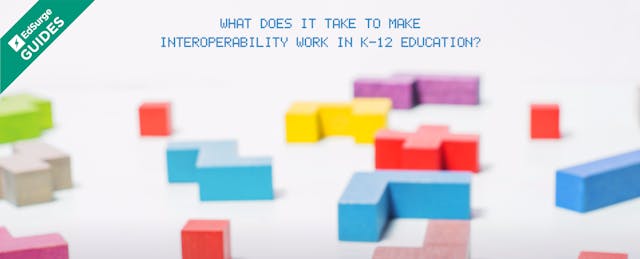Interoperability, defined dryly, is the seamless, secure and controlled exchange of data between different applications and technologies. The term is a mouthful, yet the concept enables many conveniences we take for granted. It allows, for instance, pharmacists to verify and prepare your medications after your doctor’s visit. It allows companies to pay employees via direct deposit, and for you to pay others via mobile apps or online banking services.
In education, however, interoperability has lagged behind other industries and services. Data is fragmented across different systems that don’t “speak” to one another. This means records are not easily transferable between tools used within the same school or district. Many times, products don’t even record student or achievement data in the same format, which makes it difficult to compile data into one place.
School leaders and educators who want to view data from multiple tools on one dashboard often have to repeatedly enter the data by hand, which can be time consuming. In addition, entering student information, setting up class rosters and helping students log in to online tools only adds work to a teacher’s crammed day.
Some companies are taking notice and experimenting with potential solutions. But until teachers and administrators voice their concerns en masse, these interoperability issues will remain a headache. Customer demand will drive change.
So what does it take to make interoperability work in education? In 2017, the EdSurge Research team collaborated with Getting Smart to dig into how companies and schools are trying to connect the data pipes. In the three years since, EdSurge has added to this initial body of work. In this guide, you’ll find case studies from the perspective of educators and administrators, as well as a series of profiles that share how companies are thinking, planning and guiding their product development process to address these user needs.
Schools and districts are acutely aware of the need for their applications to speak seamlessly with one another—and consequently—are demanding change. Along with designing for customer needs, companies also need to understand what it takes—the financial costs, strategic decisions and time invested—to actually “become interoperable.”
This profile is from an EdSurge Research series on interoperability. It is part of a larger collaboration called Project Unicorn led by InnovateEDU in partnership with EdSurge and 16 other organizations. The work of Project Unicorn is funded by the Michael & Susan Dell Foundation and the Bill & Melinda Gates Foundation. These stories are made publicly available with support from InnovateEDU. (Read our ethics statement here.)
This work is licensed under a CC BY-NC-ND 4.0.
What Companies are Saying
Edtech companies should consider the interoperability issues that teachers and administrators face as they design, build and iterate on their products. Deeply understanding when and why these problems arise is the first step towards solving them.
These profiles tell the story of interoperability from the perspective of five different companies. Each one dives into a different approach to interoperability and how it informs the decision-making process for product development.
What Schools are Saying
Administrators often want to see student data from various tools compiled into one dashboard. Teachers want to avoid manually entering student data into several systems when getting started with a new tool and spend less time interpreting data in multiple forms. Students and parents want a clear picture of academic performance compiled in a readable format from various learning environments.
These three case studies from Getting Smart follow school districts and networks at various stages of the interoperability journey. Each one provides a look into implementation, the story of overcoming data challenges and provides a glimpse into what is next for that model.


